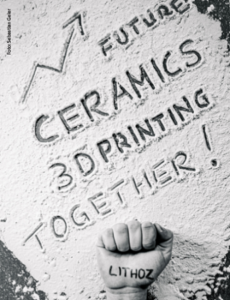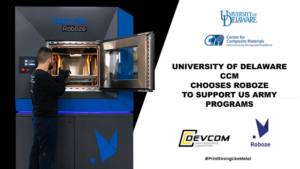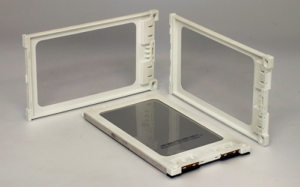We’re starting with a grand opening in today’s 3D Printing News Briefs, as Lithoz is opening its Innovation Lab. The University of Delaware has chosen Roboze technology to support its collaborative research project with the US Army, and CRP Technology published a case study. Finally, Andaltec is developing polymeric 3D printing materials with antibacterial and analgesic properties.
Lithoz Innovation Lab Grand Opening
 Austrian ceramics 3D printing company Lithoz GmbH is happy to announce the grand opening of its Innovation Lab in Vienna on May 14th, because, as the company states, “innovation needs space.” The event, held at Lithoz headquarters, will begin with a working lunch from 11:30-12:30, which be followed by a press conference and tour of the new Innovation Lab. The grand opening will take place at 2 pm, and speeches will be given by several people, including Dr. Johannes Benedikt, CTO & Dr. Johannes Homa, CEO, the co-founders of Lithoz, and Peter Hanke, the Executive City Councillor for Finance, Economy, Digitisation and International Affairs. A celebration will follow.
Austrian ceramics 3D printing company Lithoz GmbH is happy to announce the grand opening of its Innovation Lab in Vienna on May 14th, because, as the company states, “innovation needs space.” The event, held at Lithoz headquarters, will begin with a working lunch from 11:30-12:30, which be followed by a press conference and tour of the new Innovation Lab. The grand opening will take place at 2 pm, and speeches will be given by several people, including Dr. Johannes Benedikt, CTO & Dr. Johannes Homa, CEO, the co-founders of Lithoz, and Peter Hanke, the Executive City Councillor for Finance, Economy, Digitisation and International Affairs. A celebration will follow.
“It has always been important for us to support our current and future partners in innovation. Therefore we created a place where they have access to state-of-the-art technology and expertise in ceramic 3D printing,” Iveta Zitkova, B.A., Marketing and Communication for Lithoz, wrote.
University of Delaware and US Army Using Roboze ARGO 500
 The Center for Composite Materials (CCM), within the University of Delaware’s College of Engineering, is expanding its research, and selected the Roboze ARGO 500 3D printer for collaborative work it’s undertaking with the Combat Capabilities Development Center at the US Army Research Laboratory. They are researching high-temperature composite FFF 3D printing, with two main focus areas: development of a modeling and simulation software tool to increase the acceptance of 3D printed components, and actual fabrication of components for air and ground systems. The Department of Defense and the US Army want to increase speed of insertion of 3D printed parts into the appropriate logistics chains, and optimizing the virtual design process should help.
The Center for Composite Materials (CCM), within the University of Delaware’s College of Engineering, is expanding its research, and selected the Roboze ARGO 500 3D printer for collaborative work it’s undertaking with the Combat Capabilities Development Center at the US Army Research Laboratory. They are researching high-temperature composite FFF 3D printing, with two main focus areas: development of a modeling and simulation software tool to increase the acceptance of 3D printed components, and actual fabrication of components for air and ground systems. The Department of Defense and the US Army want to increase speed of insertion of 3D printed parts into the appropriate logistics chains, and optimizing the virtual design process should help.
“The Army needs to reduce logistics burdens and find ways to be adaptive to rapidly changing mission needs,” said John Gerdes, Ph.D., Team Lead (A) Technology Development & Transition at Vehicle Applied Research Division, US Army Research Laboratory. “Additive manufacturing can meet these needs, but must also offer parts with the durability and dependability that are demanded by Soldiers who rely on their equipment to accomplish critical missions.”
University faculty, students, and staff will also use the Roboze ARGO 500 as a teaching and research aid.
CRP Technology and Energica Case Study

3D printed pouch cell casings manufactured by CRP Technology using selective laser sintering
technology and Windform® FR2 for testing. User/client: Energica Motor Company
Italian company CRP Technology has long partnered with the Energica Motor Company, making 3D printed parts for its electric vehicles. CRP recently published a case study about its strategic use of SLS 3D printing technology to develop cell pouch frames to test on battery pack prototypes for Energica’s EVs. Energica’s motorcycles use a high-energy lithium polymer (Li-NMC) battery, which is contained in sealed battery cells with a patented cooling system. In order to conduct ongoing testing, the company worked with CRP to create cell pouch frames for its battery pack case prototype, which was 3D printed out of the new flame retardant, glass fiber-reinforced Windform FR2 material.
“Having built functional prototypes of pouch cell casings for various tests, including road tests, it was clear we should use a material with specific characteristics, namely: polyamide-based material, electrically insulated, stiff, resistant to temperature and flame retardant,” said Franco Cevolini, CTO and VP at CRP Technology.
“To be more specific, flame retardant characteristics are very important, because it guarantees self-extinguishing in case of operating anomalies, which are a result of a temporary voltage peak, with consequent localized melting, followed by combustion initiation.
“If an ignition/combustion occurred in a localized portion of the cell casing, and the polymer were flame retardant, then the combustion would be extinguished. Instead, if the material were not flame retardant, then serious problems would arise, because the combustion would degenerate into a fire. Windform® FR2 prevents such an occurrence.”
With CRP’s help, Energica was able to conduct all of its testing protocols for its battery pack prototype. To learn more, check out the full case study.
Andaltec 3D Printing Implants and Surgical Tools for R&D Project
 The Technological Centre for Plastics, Andaltec, is working on the R&D project PoliM3D, which is funded by the Andalusian government’s Department for Economy, Business and University. The goal of the project is to produce active 3D printing polymers that can be used in medical applications, such as implants, prostheses, and surgical tools. Andaltec’s research will develop and characterize new polymeric materials for FDM 3D printing that possess antibacterial and analgesic properties, which should help with cell growth and add value to the medical devices.
The Technological Centre for Plastics, Andaltec, is working on the R&D project PoliM3D, which is funded by the Andalusian government’s Department for Economy, Business and University. The goal of the project is to produce active 3D printing polymers that can be used in medical applications, such as implants, prostheses, and surgical tools. Andaltec’s research will develop and characterize new polymeric materials for FDM 3D printing that possess antibacterial and analgesic properties, which should help with cell growth and add value to the medical devices.
The head of the PoliM3D project, Antonio Peñas, said that using activated polymers and AM can “open up several possibilities in order to offer more affordable and efficient medical treatments,” which can equal better patient conditions. The initiative’s research work will be carried out until late 2021.
Discuss these stories and other 3D printing topics at 3DPrintBoard.com or share your thoughts in the comments below.
Subscribe to Our Email Newsletter
Stay up-to-date on all the latest news from the 3D printing industry and receive information and offers from third party vendors.
You May Also Like
Gorilla Sports GE’s First 3D Printed Titanium Cast
How do you help a gorilla with a broken arm? Sounds like the start of a bad joke a zookeeper might tell, but it’s an actual dilemma recently faced by...
Nylon 3D Printed Parts Made More Functional with Coatings & Colors
Parts 3D printed from polyamide (PA, Nylon) 12 using powder bed fusion (PBF) are a mainstay in the additive manufacturing (AM) industry. While post-finishing processes have improved the porosity of...
$25M to Back Sintavia’s Largest Expansion of Metal 3D Printing Capacity Since 2019
Sintavia, the digital manufacturing company specializing in mission-critical parts for strategic sectors, announced a $25 million investment to increase its production capacity, the largest expansion to its operations since 2019....
Velo3D Initiates Public Offering in a Bid to Strengthen Financial Foundations and Drive Future Growth
Velo3D (NYSE: VLD) has been among a number of publicly traded 3D printing firms that have attempted to weather the current macroeconomic climate. After posting a challenging financial report for 2023,...































